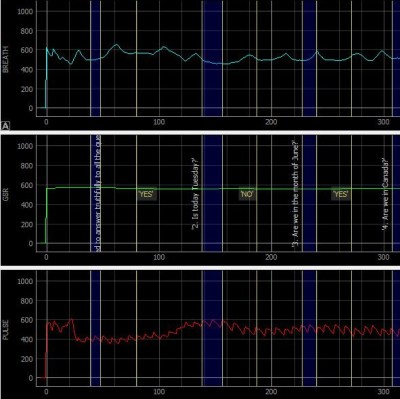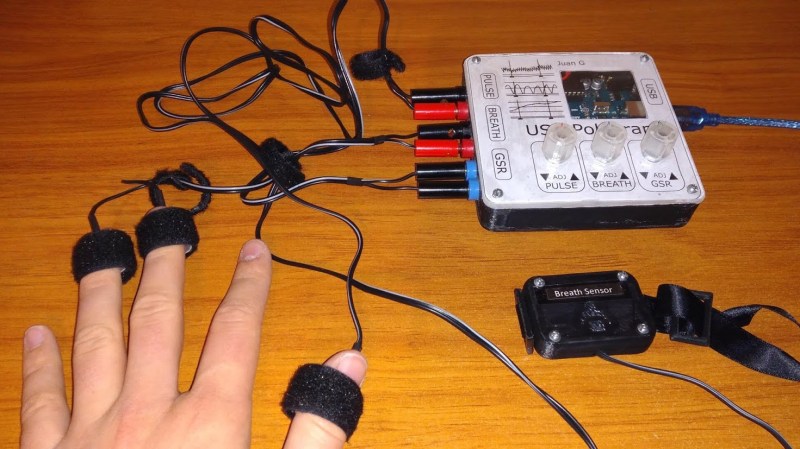 Sometimes, a project comes along that makes a good reference design for anyone doing similar work. In this particular case, it’s a DIY USB polygraph-like machine by [Juangg] using an Arduino and sensors on the hardware side, and a Python front end for data visualization. It’s even complete with 3D printed enclosure and sensor elements.
Sometimes, a project comes along that makes a good reference design for anyone doing similar work. In this particular case, it’s a DIY USB polygraph-like machine by [Juangg] using an Arduino and sensors on the hardware side, and a Python front end for data visualization. It’s even complete with 3D printed enclosure and sensor elements.
[Juangg] designed it to use three sensors: a pulse sensor, a breath sensor, and one to measure Galvanic Skin Response (GSR). The pulse sensor uses a piezo element pressed against a fingertip to detect changes in pressure resulting from blood flow. It can be picky about placement, but finding sweet spot can yield remarkably good readings. The breath sensor works on a similar principle but uses a 3D printed fixture to hold the sensor between a strap and the subject’s chest, so that breathing in and out can be detected. The GSR sensor is a voltage divider used to measure small changes in skin conductivity. How well does it all work? That depends on what one is looking to get out of it, but the documentation and design files are available from the project page and the GitHub repository if anyone wants a reference for similar work.
The polygraph may have a mixed reputation, but it makes a good project that demonstrates just how messy biometrics can be from an engineering perspective. And in case you missed it, here’s a reminder that Wonder Woman and the polygraph have much more in common than you might realize.

















So authentic! Just like a real one it can’t tell if you’re lying! :D
I can say that because I’ve taken more than twenty actual polygraphs lol
I want to use other sensors. The design is gorgeous, very good. Who is the author?
The polygraph machine is a prop to make the person being interrogated think that the machine can tell when they are lying. The questions used in the interrogation and the skill of the interrogator are the key to successful polygraph use. The same questions will be posed multiple times, phrased differently at different points during the interrogation. The interrogator will look for inconsistencies and use them to apply pressure to the subject, the goal being to obtain a confession, because the interrogator knows that the machine is useless for detecting lies, but very useful for pressuring the subject who doesn’t know that.
I was told a story by an ex police detective in the 1980’s that a couple of his colleagues had a perp they were sure had done a robbery but was sticking to his story. They told him that a Xerox machine was a “lie detector” and put a piece of paper with the word LIE written on it real big on the glass. At appropriate times during the interview they stabbed the green button and it spit out another sheet of paper that said LIE. They got their confession.
Is by any chance this was in Baltimore, I think we know the same guy?
True, happen in Baltimore. Sheeeeeit!
Look up “The Lie Behind the Lie Detector” by George Maschke and Gino Scalabrini
If you are ever forced to take a polygraph test, they will probably ask you if you’ve ever read that book…
The polygraph is about as scientifically valid as craniometry.
Well, scientifically, the lie detector works if someone come blind into the situation. Once the subject being examined knows what’s going on… and they want to lie or that part of their brain is damaged… they’ll figure out how to beat the exam.
How about some of the modern brain activity regions activity or EEG’s decoding to determine thoughts for a more accurate lie detector. Seems there are some other methods that can be added also like thermal mapping, facial pattern recognition and like I noted the other electrophysiological modalities patterns with the skill of using the training set data for modeling modds, behaviors, acts and/or events if not directly reading thoughts.
https://www.youtube.com/watch?v=Qwk2pqfYQFc
This might shed some light (I didn’t intend the pun) into the use of lasers to identify and more:
https://www.technologyreview.com/s/613891/the-pentagon-has-a-laser-that-can-identify-people-from-a-distanceby-their-heartbeat/